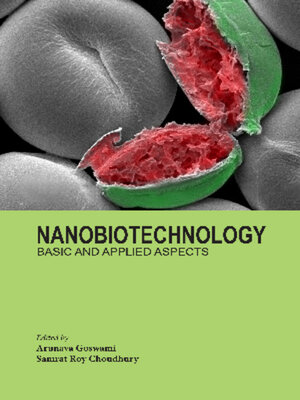
Sign up to save your library
With an OverDrive account, you can save your favorite libraries for at-a-glance information about availability. Find out more about OverDrive accounts.
Find this title in Libby, the library reading app by OverDrive.



Search for a digital library with this title
Title found at these libraries:
| Library Name | Distance |
|---|---|
| Loading... |
'Nanobiotechnology, basic and applied aspects' is expected to be of tremendous value to the group of scientists, involved in both basic and applied biology and engineering. The proposed book is a comprehensive compendium of basics of nanoscience and its application in biophysical and biomedical problems. The book describes a brief history and evolution of nanoscience in the first two chapters, which is interesting, and an enriched resource for the undergraduates of nanotechnology and biotechnology. The subsequent chapters gives an in-depth idea of different nanomaterials and their diverse biological applications such as bio-imaging, drug-development, drug-delivery, biosensors etc.. The book could also be immensely interesting for the geologists and naturalists, since it reports the occurrence of nanoparticles, which are derived from biological samples of human, and plants or of edaphic origin. In summary, the book proposed could be a reference or ready-reckoner in the undergraduate/college course-works in nanoscience and nano-biotechnology. It also gives a clear idea of different research directions in the field of nanobiotechnology.
|Richard Feynman's evolutionary idea of 'There's Plenty of Room at the Bottom' is making striking innovations in our everyday life. Our body is composed of over 32 trillion of cells, which functions by virtue of nanoscale phenomena and nano-devices. The perfect orchestration of the mechanical and molecular devices at the cellular level is the most fascinating source of motivation for scientists, engaged in the research of nanoscience and biology. A picomolar volume of DNA nicely stores all the genetic information, needed to carry out cellular differentiation, programmed cell-proliferation and cell death, and the overall functioning of the living organisms. Inter and intra-cellular exchange of ions, nutrient molecules, or protein trafficking within a cell also occur via a whole system of complex guards and finely tuned molecular apertures. The biological network, which is developed in microbes, are again controlled with a molecular biosystem, distinctly different from human or higher grade of plants. These biological nanomachines inspires biologists and engineers to simulate the working-finesse of these molecular biosystems for scientific and industrials benefits and purposes.
The major goal in the nanoparticle research hence is aimed at developing new drugs for precise targeting to the disease site, effective killing of harmful microorganisms, bio-sensing in the agricultural and food industry, acute and precise bioimaging for better diagnosis of a disease or for continuous improvement of bioinstruments like microscopes etc. The list is expanding and including almost all aspects of our life. One of the major challenges in exploration into the sub-atomic size is to obtain a stable nanodevice, since at nanoscale most of the elements become highly reactive yet unstable.
Along each chapter of the book, readers will realize with amazements and wonder that at the nano-size how a materials behaves dramatically different, compared to their bulk size. It's highly interesting to observe, how different nanomaterials (metal, non-metals, polymeric, or magnetic) have been implicated for different biological and biomedical problems. Each chapter provides an insight into the applications of nanomaterials in different biological and biomedical purposes. Undoubtedly, it is a ready reckoner for both the young and advance level researchers in the field of nanoscience and nanotechnology.







